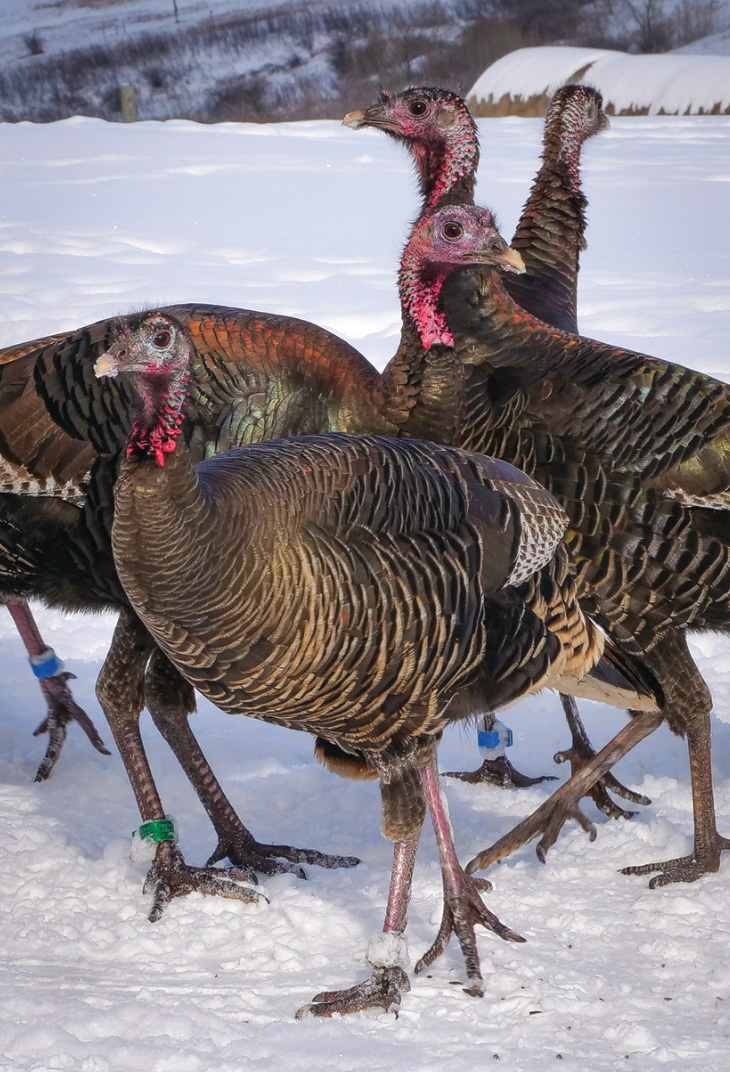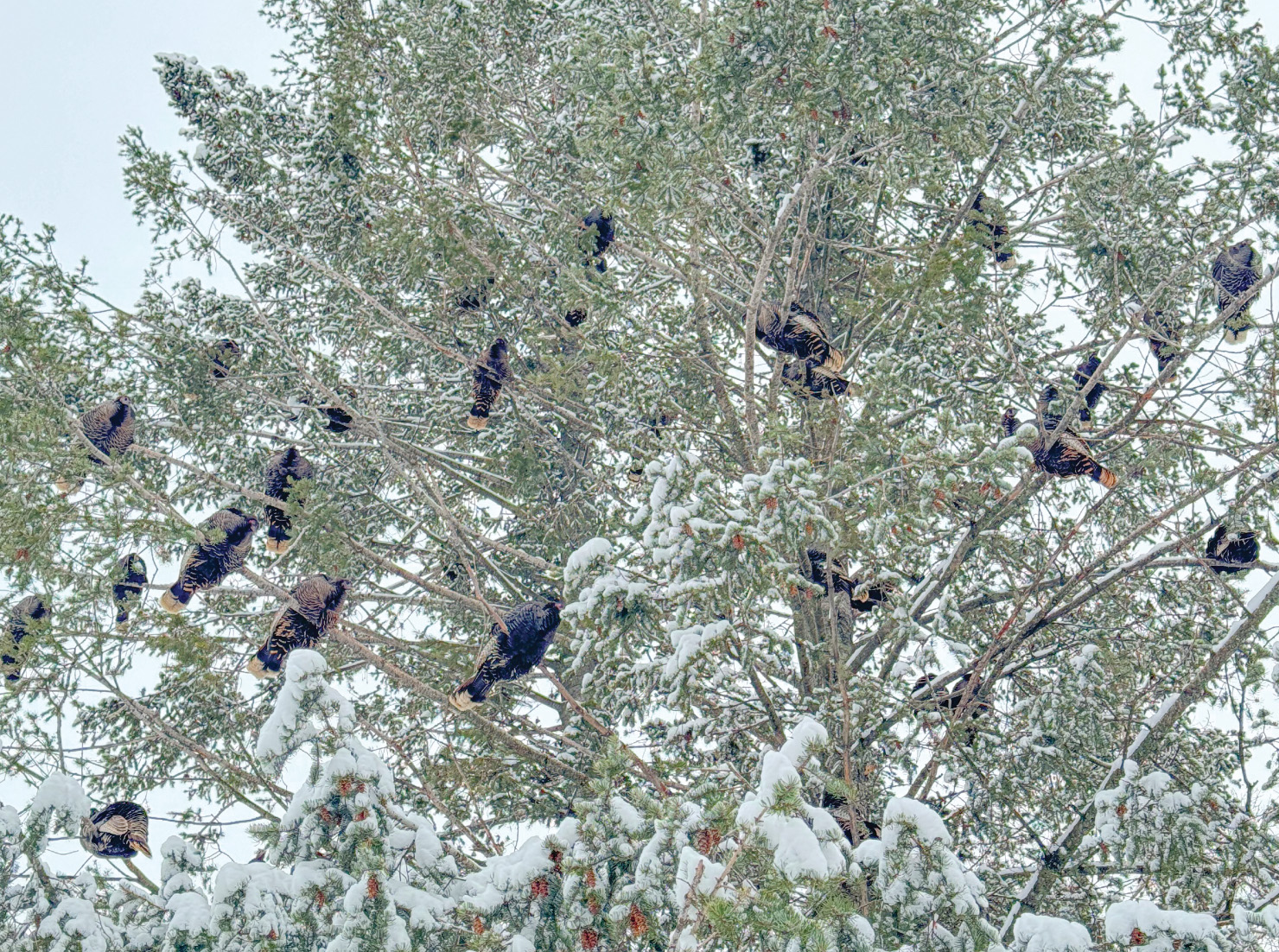
6 minute read
Turkey Teamwork
Landholders Play a Key Role in Translocation
► by Amanda Gill
It’s a crisp afternoon. The light snow has tapered off and the clouds have dissipated to reveal a clear blue sky and the sun reflecting off the snow-covered hills. It couldn’t be a better winter day to be outdoors in southern Alberta. It was in this beautiful setting that I had the opportunity to participate in a wild turkey translocation release, an Alberta Conservation Association (ACA) project in its second year.

Merriam’s turkeys were introduced in Alberta in 1962, with 21 turkeys translocated from South Dakota to the Cypress Hills area, with some relocated to the Porcupine Hills about ten years later. The population grew, but over the past 10-20 years it has declined.
ACA’s Senior Scientist and Wildlife Program Manager, Dr. Doug Manzer, mentions that several factors have likely contributed to the decline. "The number of areas with viable groups of birds have decreased and become isolated from one another as some pockets have winked out, making it difficult for birds to find a mate.” Doug adds, “Different from other Galliformes like grouse and pheasants, turkeys do not breed at one year old. It’s only when they become two years old that both hens and toms become viable. The age structure of the population within each local area where they occur is vitally important— they have slower growth cycles when compared to other grouse-like birds.”
To make matters more challenging, Manzer suggests that hens at this latitude may not begin laying until mid- to late-May. If mature males are harvested in early May before hens in that area are bred, it’s likely there won’t be many hens bred in the spring. Of the 183 wild turkeys translocated in winter 2024, only eight percent were toms old enough to breed this spring—that’s only 15 toms!
ACA is trying to boost the population with pockets of 20-30 birds spread across the region, but “…we’re often left with only one or two adult males to mate with all the hens in each area. If any of the males are taken before they breed with hens, then we’ll see unbred hens again this spring. We don’t have perfect information to say exactly what’s happening,” says Manzer. “…but the ratio of adult males to females is almost certainly a factor that’s leading to low recruitment when aggregated across the region.”
Where do you start when trying to detect population trends with a wild species? On a recent episode of ACA’s Harvest Your Own podcast, Doug advised that, “Turkeys are fairly difficult to survey with any degree of accuracy.” To get a better understanding, ACA has reached out to landholders from Longview to Cardston since 2021, asking them to report sightings of turkeys over the winter period. The region was divided into five zones, and ACA learned that numbers have declined markedly in four of the five zones over the past 20 years.
ACA has also reached out to the public, including those same landholders, to report sightings from July through October to gain a measure of annual recruitment. “The ratio of poults [young turkeys] per hen across the entire region has been below the threshold needed for recovery,” says Manzer. “We’re seeing pockets of hens that are geographically isolated from breeding aged males, and they’re going through spring and summer without breeding.”
One province over in B.C., the wild turkey population is considered abundant, with some turkeys wandering and staying in urban areas—roosting in backyard trees, pecking and scratching reflective surfaces on vehicles, and chasing citizens down the street! ACA reached out to B.C. to see if we could translocate wild turkeys to jump start the population in Alberta. They agreed, and in the winters of 2023 and 2024, ACA captured birds in southeastern B.C. where they were living within towns and residential areas.

These “problem” birds were released in southwestern Alberta, where annual translocations are aimed at increasing Alberta’s population over the next eight to ten years. This is where the landholders are essential to the success of this project. Landholders need to be willing to have wild birds on their property and provide the means to feed them, especially in the winter. In talking with a landholder about their thoughts, I learned that their family has a history with wild turkeys that stretches back to the 1970s. When approached last year about participating in ACA’s project, it was an easy decision. Turkeys were once common on ranches, and landholders are excited to see that again in Alberta.
ACA staff and landholders join in to safely release the turkeys. The birds only take a few seconds to spread their wings and go—and it’s a large wingspan at that, up to 57 inches! Their thick plumage shifts with the light—iridescent emerald and bronze, rich chocolatey brown, and a scattering of white, black, and beige. Soon, all the birds are roosting high up in the trees.
Landholders make days like this possible, making a difference in conservation efforts. As Doug concludes, “We’ve had an overwhelmingly positive response from landholders, who are essential and have a vital role in this project.” Working together towards a shared goal is what makes conservation so rewarding and will build up the population in Alberta for future hunting opportunities.

Moving In
What can landholders expect with wild turkeys on their land?
The best option for wild turkeys is to be translocated onto working ranches that feed cattle over winter. Turkeys will often stay in one area if they have access to daily feed.
Turkeys can be sneaky, sometimes getting into green feed bales for an extra meal. Landholders may need to tarp those to keep the turkeys out.
Turkeys like to roost in trees, especially large spruce and fir trees. Ideal host locations have mature conifers. Once turkeys find a tree they prefer for roosting, they may continue to use it through many generations year over year.
Turkeys tend to move during the spring breeding season and could end up on your neighbours’ land. Let them know there may be wild turkeys in the area.
Get Involved
Are you an Alberta landholder interested in hosting translocated turkeys? Reach out to info@ab-conservation.com










